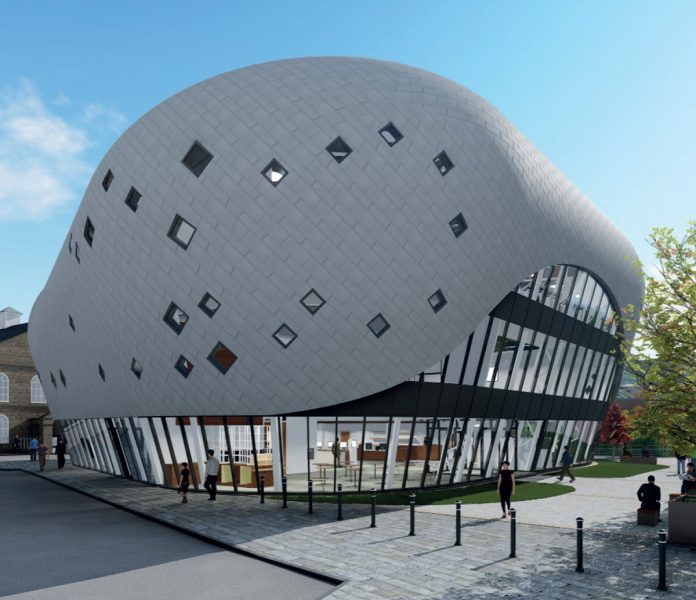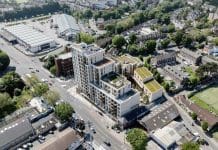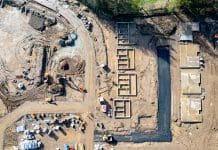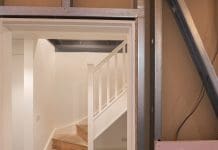Due to be completed in Spring 2020, the Taff Vale redevelopment scheme is the start of a major new regeneration project for Pontypridd
In recent years the decline of development in Pontypridd, South Wales has in part been the result of a neighbouring city’s own success; the regeneration projects in nearby Cardiff have resulted in business and employment opportunities moving away from the local area. Rhondda Cynon Taff County Borough Council has commissioned Willmott Dixon to develop an ambitious project to kickstart Pontypridd’s resurgence, providing much-needed space for employment and for the community.
The new development comprises three buildings – two office blocks and a flagship community building, containing community facilities, a library, council offices, leisure and fitness centre, retail unit, and café. All three buildings share the same reinforced concrete basement and podium design. The two office buildings are similarly designed 5-storey, steel-framed blocks. The office-led scheme will lead to the creation of more jobs and increase footfall to Pontypridd town centre, with the knock-on effect of making the town more attractive for potential retailers.
The main community building is an architectural feature and is correspondingly more complex. It is constructed using steel, in-situ cast reinforced concrete, brick, glass, prefab timber cladding units, and individually sized and shaped zinc cladding panels. The roof structure is particularly visually striking. Its semi-monocoque design curves in two directions via a steel frame which connects to the reinforced concrete core. The frame supports prefabricated timber cassettes that are bolted back to the steel. Thin timber planks are used to form the curves of the façade and individual zinc shingle panels (6,345 in total) are fixed using a clamp to form the outer face.
Overcoming challenges
Creating a project with unique design features comes with its own set of challenges and, on this project, it started with the foundations. For the piling, supporting a 375mm thick slab at podium level, with concrete columns on a 6.5-7.5m grid, required 680 CFA piles at 650mm in diameter, stretching 25m deep. A 130-tonne rig was used to install the piles, requiring night-time road closures and monitoring of the main bridge into town.
Unsurprisingly the construction of the façade is one of the project’s most difficult elements. Due to its curvature, the façade splays out in places, creating a 2m overhang from the base of the building. The design means there are areas where the windows are almost tilting back on themselves. The importance of getting drainage right has been a particular consideration. Glazed curtain walling completes the exterior of the main community building at ground-floor level. This is also installed at a splayed angle that falls back on itself. Only robust engineered timber beams around the base of the zinc cladding and the top of the curtain wall prevent any damage.
An additional challenge was the brickwork. Despite the futuristic look and innovative design, it was decided to use traditional brickwork rather than pre-cast concrete. However, to add individuality to the design, a Danish standard brick was chosen, which, at 228 x 108 x 54mm, is longer, wider, and shallower than the UK standard. The project team had to purchase the bricks in advance to guard against any potential disruption caused by Brexit. The size of the brick resulted in different setting‑out; half-bricks in unexpected locations and tighter tolerances.
Sustainable and a community benefit
Sustainable construction, including the use of materials and construction methods, have been designed into the project as an important part of achieving a BREEAM rating of Excellent. The elements include photovoltaic panels on the roof of the two office buildings, rainwater harvesting tanks in the plant rooms and the use of a number of prefabricated, modular elements, for example, the timber cassettes forming the community building façade. The project team has also made use of BIM in order to track and measure its progress towards achieving its BREEAM target.
As well as the sustainable construction elements, the project team has placed an emphasis on the wider community benefit of the construction phase, including the delivery of training and job opportunities. The programme includes partnering with the University of South Wales to offer work experience and training for students and appointing a community liaison officer to provide mentoring and experience for the unemployed and those not in training or education.
The JCT Design and Build Contract facilitates collaboration between the client and main contractor and is especially useful where there are a number of complex design elements, where the contractor is to carry out the design of the works. With a dependable, flexible contract to facilitate the smooth operation of the works, The Taff Vale Redevelopment is able to focus on its main goal – delivering real benefit to the town of Pontypridd.
Taff Vale Redevelopment, Pontypridd
Client: Rhondda Cynon Taff County Borough Council
Contractor: Willmott Dixon
Architect: DarntonB3 Architecture
Piling Contractor: DWestpile
Timber specialist: Constructional Timber
Cost: £40m
Contract: JCT Design and Build Contract
Start Date: March 2018
Completion: Spring 2020
Read more here.
Don’t miss out on the last few places for our JCT Design and Build Contract 2016 training course.
Book your place today here.
*Please note: this is a commercial profile.














